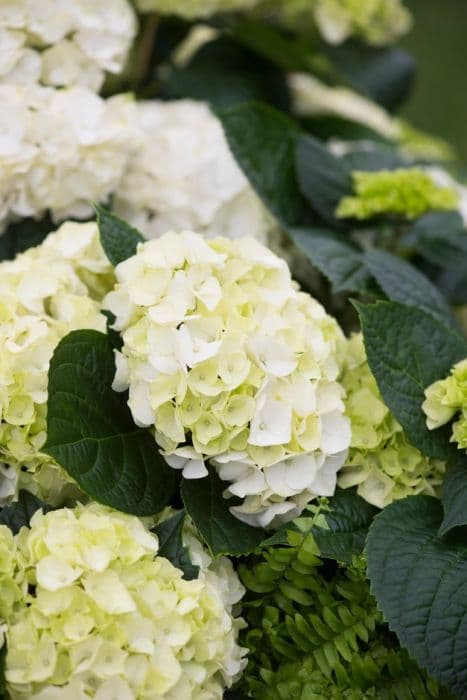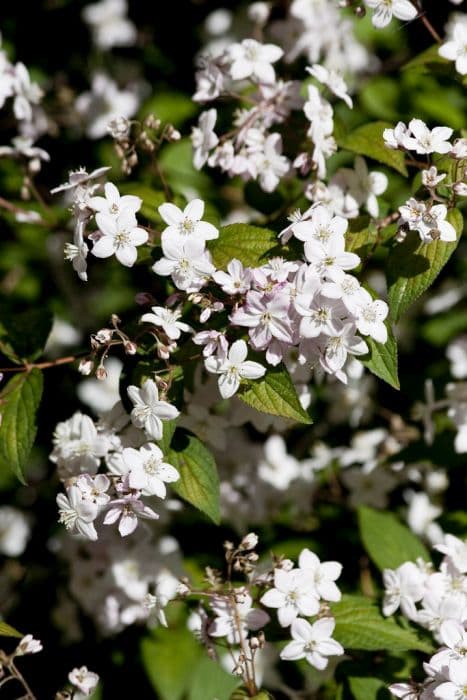Bigleaf Hydrangea Hydrangea macrophylla 'Wudu' (PBR) (H)

ABOUT
The Hydrangea, known by the cultivar name 'Wudu', is a strikingly beautiful plant that is particularly admired for its large, vibrant blossoms. The flowers of this Hydrangea are typically lush mophead inflorescences, which means they form rounded, globe-like clusters that are quite dense and full. These blooms come in a variety of shades that can range from deep blue to rich pink, often influenced by the acidity or alkalinity of the soil in which the plant is grown. The leaves of the Hydrangea 'Wudu' are also noteworthy, being broad, ovate and having a lush green color that forms a lovely backdrop for the colorful flowers. During the blooming period, the plant becomes a focal point in any garden due to its extravagant display of flowers which can cover the bush in a profusion of color. In terms of overall appearance, the plant displays a robust and bushy habit with stout stems that support the weight of the flowers. The texture of the plant is mostly smooth with a combination of its glossy leaves and relatively smooth stems. As the seasons change, the color of the flowers can transform, offering a dynamic element to its appearance. The aesthetic appeal of the Hydrangea 'Wudu' lies not only in its blooms but also in its sturdy, verdant foliage, which provides a beautiful contrast and adds to the lushness of garden settings. This Hydrangea is favored for its ability to bring splashes of color that can range from soft pastels to bold hues, depending on the pH levels of the soil it is grown in.
About this plant
 Names
NamesFamily
Hydrangeaceae
Synonyms
Bigleaf Hydrangea, French Hydrangea, Lacecap Hydrangea, Mophead Hydrangea, Hortensia, Garden Hydrangea
Common names
Hydrangea macrophylla 'Wudu' (PBR) (H).
 Toxicity
ToxicityTo humans
The common name for Hydrangea macrophylla 'Wudu' is simply Hydrangea. Hydrangeas are considered to be mildly toxic if ingested. The plant contains compounds that release cyanide when chewed or broken down in the body. Symptoms of hydrangea poisoning may include gastrointestinal upset, such as vomiting and diarrhea, and in more severe cases, depression, lethargy, and confusion due to the cyanogenic glycoside found in the plant. It's important to seek medical attention if hydrangea poisoning is suspected.
To pets
The common name for Hydrangea macrophylla 'Wudu' is Hydrangea, which is potentially toxic to pets if ingested. The toxicity comes from cyanogenic glycosides found in the plant, which can release cyanide when ingested. Common symptoms of hydrangea poisoning in pets include vomiting, diarrhea, and depression. On occasion, with significant ingestion, more serious symptoms such as lethargy, abdominal pain, and confusion may occur. If a pet ingests hydrangea, immediate veterinary care is recommended.
 Characteristics
CharacteristicsLife cycle
Perennials
Foliage type
Deciduous
Color of leaves
Green
Flower color
Varies
Height
3-6 feet (0.9-1.8 meters)
Spread
3-6 feet (0.9-1.8 meters)
Plant type
Shrub
Hardiness zones
5-9
Native area
Japan
Benefits
 General Benefits
General Benefits- Ornamental Appeal: Hydrangea macrophylla 'Wudu', commonly known as bigleaf hydrangea, features large, colorful blooms that enhance the visual appeal of gardens and landscapes.
- Seasonal Interest: Bigleaf hydrangea offers a long flowering period, typically from early summer to late fall, providing prolonged interest throughout the growing season.
- Variety of Colors: Depending on the soil pH, the flowers can range from blue to pink, allowing gardeners to create diverse color schemes in their planting designs.
- Shade Tolerance: Bigleaf hydrangea can tolerate and thrive in partial shade, making it a versatile choice for garden spots that don't receive full sun.
- Attracts Pollinators: The flowers attract bees and other pollinators, contributing to the health of the garden ecosystem.
- Easy Pruning: It requires minimal pruning, which can be beneficial for beginner gardeners or those looking for low-maintenance plants.
- Soil Adaptability: While it prefers moist, well-drained soil, bigleaf hydrangea is adaptable to various soil types, which can be an advantage in less-than-ideal garden conditions.
 Medical Properties
Medical PropertiesThis plant is not used for medical purposes.
 Air-purifying Qualities
Air-purifying QualitiesThis plant is not specifically known for air purifying qualities.
 Other Uses
Other Uses- As a dye: The vibrant blooms of hydrangeas can be used to create natural dyes for fabrics, offering hues that range from pale pinks to deep blues, depending on the pH level of the soil they were grown in.
- In craft projects: Dried hydrangea flowers retain their shape and color, making them ideal for use in wreaths, dried floral arrangements, or as part of mixed-media art projects.
- Edible decorations: While not all parts are edible, some hydrangea petals can be crystallized and used as edible decorations for cakes and desserts.
- In cosmetics: The extracts from hydrangea leaves can be used in cosmetic formulations for skin care products, owing to their potential anti-inflammatory properties.
- As a pH indicator: The flower color changes with soil pH, and the flowers can be used as a rough, natural pH indicator for educational purposes or garden soil testing.
- Preserved flower jewelry: Tiny hydrangea flowers can be preserved in resin to create unique pieces of jewelry such as earrings, pendants, or bracelets.
- Photography props: Because of their large, attractive blooms, hydrangeas can be used as props or backgrounds in photography, especially in portrait and product shoots.
- Leaf casting: Large hydrangea leaves can be used to make decorative concrete or plaster casts for garden ornaments or wall hangings.
- As a natural confetti: Dried, crumbled petals of hydrangeas can be used as biodegradable confetti for outdoor celebrations, reducing environmental impact.
- In bookmarks and stationery: Hydrangea petals and flowers can be pressed and used to embellish bookmarks, greeting cards, or other types of stationery for a floral touch.
Interesting Facts
 Feng Shui
Feng ShuiHydrangeas are not specifically used in Feng Shui practice.
 Zodiac Sign Compitability
Zodiac Sign CompitabilityHydrangeas are not used in astrology practice.
 Plant Symbolism
Plant Symbolism- Heartfelt Emotions: Hydrangeas often symbolize deep and heartfelt emotions due to their lush and abundant flower heads.
- Gratitude: These plants can represent gratitude for being understood, reflecting their use as gifts to express thanks.
- Boastfulness or Vanity: In some cultures, hydrangeas are associated with boastfulness or vanity, potentially stemming from the plant’s showy appearance.
- Apoplectic or Frigidness: The plant is sometimes tied to a negative symbolism of apoplectic or cold feelings, as a result of a specific interpretation of the hydrangea’s medicinally useful yet potentially toxic properties.
- Fourth Wedding Anniversary: Hydrangeas are often used to celebrate the fourth wedding anniversary, symbolizing appreciation and enduring love.
 Water
WaterThe common name of Hydrangea macrophylla 'Wudu' is Bigleaf Hydrangea. Water these hydrangeas deeply once a week, and more frequently if the weather is very hot or dry. A general rule is to ensure they receive at least 1 inch of water per week, whether from rainfall or manual watering. During the growing season, it can be beneficial to provide additional waterings, but always check the soil moisture level first to avoid overwatering—a common mistake. Use a soaker hose or drip irrigation to water the plants slowly and deeply, ensuring that the water penetrates the soil to reach the roots rather than just wetting the surface.
 Light
LightBigleaf Hydrangeas thrive best in a location where they are protected from the hot afternoon sun. They can tolerate full morning sun with partial shade in the afternoon, as intense sun can scorch their leaves and affect bloom production. The ideal spot is one that receives dappled sunlight throughout the day, or bright, indirect light that mimics the conditions of their natural woodland habitat.
 Temperature
TemperatureBigleaf Hydrangeas prefer temperate climates and flourish in a range of 65°F to 75°F, which is their ideal temperature for robust growth. They can survive a minimum temperature down to around 20°F, though prolonged exposure to freezing conditions can damage the plants. To prevent frost damage, protect these hydrangeas when temperatures dip below freezing, especially in the early spring when new growth is most vulnerable.
 Pruning
PruningPrune Bigleaf Hydrangeas to remove dead wood and to shape the plant or control its size. The best time to prune is after they have finished flowering, usually by mid-summer, to avoid cutting off next year's flower buds. This hydrangea species blooms on old wood, so limit pruning to just the dead or weak stems, unless necessary for the health of the plant.
 Cleaning
CleaningAs needed
 Soil
SoilBigleaf hydrangeas thrive in rich, porous, moist soil with good drainage and a pH that affects flower color—acidic (pH below 6) for blue flowers, and more alkaline (pH above 7) for pink. A mix of garden soil, peat moss, and perlite in equal parts can create an ideal growing medium.
 Repotting
RepottingBigleaf hydrangeas generally need repotting every 2-3 years, or when the root system outgrows the current container, which is evident when roots start to circle the pot or grow through drainage holes.
 Humidity & Misting
Humidity & MistingBigleaf hydrangeas prefer moderate to high humidity levels, around 50-60%, for optimal growth—too low humidity may lead to leaf desiccation and flower bud loss.
 Suitable locations
Suitable locationsIndoor
Place in bright, indirect light and maintain consistent moisture.
Outdoor
Choose a spot with morning sun and afternoon shade; keep soil moist.
Hardiness zone
6-9 USDA
 Life cycle
Life cycleThe life of the Hydrangea macrophylla, commonly known as Bigleaf Hydrangea, begins with seed germination, which occurs in warm, moist soil conditions usually in spring. Seedlings emerge and establish a root system, followed by the development of foliage; in this juvenile phase, the plant focuses on vegetative growth. As the Hydrangea matures, it enters the flowering stage, typically in early summer, where it produces large, showy flower heads that can be blue, pink, or purple depending on soil pH. Post bloom, the flowers may fade and dry on the plant, which then enters a period of energy conservation and preparation for dormancy. In autumn, leaves may change color and drop as the plant goes dormant to survive winter conditions, particularly in colder climates. Come spring, the cycle recommences with new growth from overwintering buds, and the Hydrangea continues to grow and potentially increase in size each year.
 Propogation
PropogationPropogation time
Spring-Early Summer
Hydrangea macrophylla 'Wudu', commonly known as Bigleaf Hydrangea, is best propagated by semi-hardwood cuttings. This method is popular because it is relatively easy and has a high success rate. Cuttings should be taken in late summer, when the wood of the new growth has begun to mature. Cut a 4 to 6 inch (10 to 15 cm) length of stem that includes several pairs of leaves. The lower leaves should be removed and the cut end dipped in rooting hormone to encourage root development. The cutting is then inserted into a pot filled with a well-draining medium such as a mix of peat and perlite. The pot should be kept in a warm, humid environment with indirect sunlight until roots have formed, which usually takes a few weeks.






![Hydrangea [Pink Annabelle] ('Ncha1')](/_next/image?url=https%3A%2F%2Fplants-admin.emdemapps.com%2Fimages%2Fplants%2F%2Fimages%2F604b576c63619.png&w=640&q=75)
![Hydrangea [Deep Purple Dance]](/_next/image?url=https%3A%2F%2Fplants-admin.emdemapps.com%2Fimages%2Fplants%2F%2Fimages%2F604b593beaa47.png&w=640&q=75)

